 |
APU students have long been involved in extracurricular
activities, both on- and off-campus.The range of extracurricular
activities has broadened enormously, with some students working
to revitalize the local community, and others turning their eyes
and efforts to other parts of the world.
We would like to introduce two outstanding groups : one which recently
traveled to Beijing to meet with fellow university students, and
another which strives for community development in Kamegawa -an
area of Beppu where a significant number of APU students live. |
|

| |
|

 |
 |
 |
APU Student Cultural Interaction
Mission to Beijing |
 |
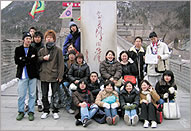
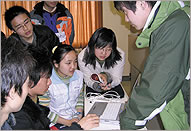
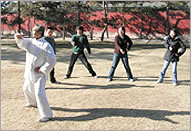 |
 |
 Approximately 25 APU students from four
clubs (including Tianxia, Japanese drumming club Wadaiko "Raku", J-Language
Net and the Chinese Shadow Boxing Club) departed for Beijing on March
1, 2005. The positive response to the Wadaiko "Raku" performance in June
2004 from the students at City of University of Hong Kong led to this
year's trip. The purpose of which was to facilitate a better understanding
between students of Japan and China by introducing Japanese culture and
APU. For 15 days the group toured Chinese cultural sites and interacted
with students of Tsinghua University and Beijing Foreign Studies University -two of China's leading universities. Approximately 25 APU students from four
clubs (including Tianxia, Japanese drumming club Wadaiko "Raku", J-Language
Net and the Chinese Shadow Boxing Club) departed for Beijing on March
1, 2005. The positive response to the Wadaiko "Raku" performance in June
2004 from the students at City of University of Hong Kong led to this
year's trip. The purpose of which was to facilitate a better understanding
between students of Japan and China by introducing Japanese culture and
APU. For 15 days the group toured Chinese cultural sites and interacted
with students of Tsinghua University and Beijing Foreign Studies University -two of China's leading universities. |
 |
 |
Impressed by the Japanese
Conversational Ability of the Chinese Students |
 |
 |
 At Tsinghua University, the activities
commenced with Chinese students practicing ethnic music with students
from a first-year Japanese language class. During the practice sessions
APU visitors were astonished at the Tsinghua students' high level of
conversational ability. After only half a year of study the Chinese students
were able to comfortably hold conversations in Japanese astonishing members
from the J-Language Net. At Tsinghua University, the activities
commenced with Chinese students practicing ethnic music with students
from a first-year Japanese language class. During the practice sessions
APU visitors were astonished at the Tsinghua students' high level of
conversational ability. After only half a year of study the Chinese students
were able to comfortably hold conversations in Japanese astonishing members
from the J-Language Net. |
 |
 |
Interaction through Culture
Introduction Booths |
 |
 |
 Individual clubs ran cultural booths at
both Chinese universities providing a forum for cultural interaction.
Tianxia was in charge of APU public relations and holding a Japanese
cuisine event; while the Chinese shadow boxing club handled Japanese
tourism and introduced Japanese mobile phones. J-Language Net held a
Japanese-language class and the Japanese drumming group Raku introduced
traditional Japanese culture. This cooperation between multiple clubs
made it possible to cover a wide variety of topics. Even students who
understood little Japanese or English listened with interest to what
the APU students had to say. Individual clubs ran cultural booths at
both Chinese universities providing a forum for cultural interaction.
Tianxia was in charge of APU public relations and holding a Japanese
cuisine event; while the Chinese shadow boxing club handled Japanese
tourism and introduced Japanese mobile phones. J-Language Net held a
Japanese-language class and the Japanese drumming group Raku introduced
traditional Japanese culture. This cooperation between multiple clubs
made it possible to cover a wide variety of topics. Even students who
understood little Japanese or English listened with interest to what
the APU students had to say.
 The group members also enjoyed some special experiences unique to China, such
as a performance and introductory session by a master of Chinese shadow boxing
in Beijing's Ditan Park. The group members also enjoyed some special experiences unique to China, such
as a performance and introductory session by a master of Chinese shadow boxing
in Beijing's Ditan Park. |
 |
 |
The Outcome |
 |
 |
 The participants described their experiences
during the 15-day visit to China as insightful and meaningful. Some of
the students had the following to say: " I felt first-hand the depth
and breadth of Chinese history ;" " I was faced with many historical
issues and thought about them deeply; " and " I was able to
exchange thoughts on Chinese shadow boxing in Beijing, and how they are
operated and developed. " The mission was a success thanks to the
cooperation of individual clubs, and the invaluable assistance from the
Chinese club members. It was yet another richly rewarding overseas visit
that utilized APU's unique multi-cultural environment. The participants described their experiences
during the 15-day visit to China as insightful and meaningful. Some of
the students had the following to say: " I felt first-hand the depth
and breadth of Chinese history ;" " I was faced with many historical
issues and thought about them deeply; " and " I was able to
exchange thoughts on Chinese shadow boxing in Beijing, and how they are
operated and developed. " The mission was a success thanks to the
cooperation of individual clubs, and the invaluable assistance from the
Chinese club members. It was yet another richly rewarding overseas visit
that utilized APU's unique multi-cultural environment. |

| |
|

 |
 |
 |
Creating the Future by Incorporating
the Past |
 |
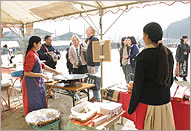
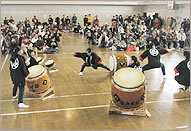
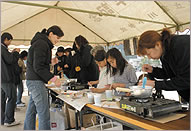
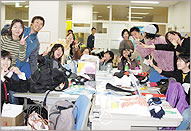 |
 |
 The Kamegawa region of Beppu City, with
its many hot springs and traditional cityscape, is home to many APU students.
On December 18, 2004 the Kamegawa Cultural Festival Executive Committee
held its first Cultural Festival. The theme of the event was "Creating
the Future by Incorporating the Past". Proposals aimed at revitalizing
the local community in Kamegawa and creating new collaborative relations
were drawn up. The Kamegawa region of Beppu City, with
its many hot springs and traditional cityscape, is home to many APU students.
On December 18, 2004 the Kamegawa Cultural Festival Executive Committee
held its first Cultural Festival. The theme of the event was "Creating
the Future by Incorporating the Past". Proposals aimed at revitalizing
the local community in Kamegawa and creating new collaborative relations
were drawn up. |
 |
 |
Dreams Realized after a
Long Preparation Period |
 |
 |
 The Executive Committee consisted of about
30 members. Work commenced in August and meetings were held every day
to prepare for the event. While working on the pamphlets and finances,
local companies and the media were contacted for support. None of the
committee members had any prior experience in planning an event for the
expected 1000 plus turnout, and they ran into various problems. For example,
preparations were hurried along and the pamphlets had to be completed
in a very tight time frame of only one week. However, thanks to the united
efforts of the committee and the cooperation of many people the Cultural
Festival went ahead as planned. The Executive Committee consisted of about
30 members. Work commenced in August and meetings were held every day
to prepare for the event. While working on the pamphlets and finances,
local companies and the media were contacted for support. None of the
committee members had any prior experience in planning an event for the
expected 1000 plus turnout, and they ran into various problems. For example,
preparations were hurried along and the pamphlets had to be completed
in a very tight time frame of only one week. However, thanks to the united
efforts of the committee and the cooperation of many people the Cultural
Festival went ahead as planned. |
 |
 |
Celebrating Cultural Diversity |
 |
 |
 On the day of the festival a variety of
APU clubs ran events on the grounds of the Kamegawa Elementary School
drawing on the multi-cultural environment of APU. Clubs included: Yosakoi
Japanese drumming, a fashion show showcasing ethnic costumes from many
Asian lands, and more. Events deeply rooted in the local area were also
held such as a photographic exhibition of the region over the years and
a walking tour. The diverse content of the festival, which was made possible
by the cooperation of past and present residents fascinated visitors. On the day of the festival a variety of
APU clubs ran events on the grounds of the Kamegawa Elementary School
drawing on the multi-cultural environment of APU. Clubs included: Yosakoi
Japanese drumming, a fashion show showcasing ethnic costumes from many
Asian lands, and more. Events deeply rooted in the local area were also
held such as a photographic exhibition of the region over the years and
a walking tour. The diverse content of the festival, which was made possible
by the cooperation of past and present residents fascinated visitors. |
 |
 |
Efforts of Executive Committee
Lead to foundation of (KAME) OKOSHI |
 |
 |
 Members from the Executive Committee went
on to establish a group designed to assist the continued development
of the Kamegawa region. The "(KAME) OKOSHI" group consists of 12 members
including several students from APU. The word "okoshi" derives from the
old name for the Kamegawa region, which was Okoshi-machi, and plays on
the Japanese word meaning to revitalize or develop a community. Members from the Executive Committee went
on to establish a group designed to assist the continued development
of the Kamegawa region. The "(KAME) OKOSHI" group consists of 12 members
including several students from APU. The word "okoshi" derives from the
old name for the Kamegawa region, which was Okoshi-machi, and plays on
the Japanese word meaning to revitalize or develop a community.
 To ensure that this is not a one-off event, surveys and interviews will be
conducted on the Kamegawa region, and future planning will emphasize activities
that promote local interaction. To ensure that this is not a one-off event, surveys and interviews will be
conducted on the Kamegawa region, and future planning will emphasize activities
that promote local interaction. |
 |
 |
|




 |
Beijing Cultural Interaction Mission |
|
 |


 |
 |









